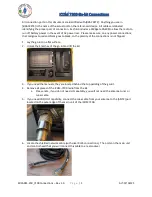
3-6
Transmitter Main Board Instruction Manual
To remove the Enhanced Synthesizer or Crystal Controlled Oscillator module, simply remove the
center screw from the module lid and pull the module out. The module should be pulled straight
out so that the four alignment pins do not bend or damage the circuitboard.
The Low Power Synthesizer uses two tabs soldered to the Transmitter Main Board for mounting.
No alignment pins are used. As a result care must be taken to ensure the connector pins on the
bottom of the Synthesizer are not bent. To install the low Power Synthesizer module, remove the
two of the synthesizer side screws that correspond to the tabs on the Transmitter Main board and
install the synthesizer module taking care not to bend the pins. Replace the two side screws;
installing them through the tabs to hold the synthesizer module in place.
When removing the Low Power Synthesizer module, it is important to gently lift the synthesizer
module "straight out" in order to prevent damage to the connector pins. Remove the two side
screws holding the sinthesizer module to the tabs. Using a plastic coated lifting tool, such as a
small screwdriver with the tip covered in heat shrink material, gently lift the synthesizer module
from the Transmitter Main Board by applying pressure in a rotating fashion about four corners of
the synthesizer module. Replace the two side screws.
3.8
MT-3 Audio Processor Alignment (Version 1.6)
invisible text
3.8.1 General
Verify the standard factory settings for the MT-3 Audio Processor as given in section 3.5.2 before
beginning the standard deviation adjustment procedure. If the transmitter's channel frequency
changes, the audio processor should be realigned to optimize the transmitter's performance. The
schematic diagram for the audio processor is shown in section 5.4.2 and the component layout is
shown in section 5.4.1.
3.8.2 MT-3 Audio Processor Standard Deviation Adjustment
Note: clockwise rotation of controls increases signal levels.
1
Connect the transmitter to the radio communications test set and monitor FM
deviation, distortion, and audio frequency. Before adjusting the audio deviation,
confirm that the transmitter RF output frequency is correct.
2
Connect the 600 ohm input to the incoming audio (pins B18, Z18). Set the audio
frequency to 1 kHz at the desired level of -8 dBm.
3
Increase the balance level control (R31) for maximum gain.
Summary of Contents for VT-3/140-SWA2
Page 28: ...vi Transmitter Main Board Instruction Manual This Page Intentionally Left Blank ...
Page 62: ...4 2 Transmitter Main Board Instruction Manual This Page Intentionally Left Blank ...
Page 106: ...6 2 Audio Processor Board Instruction Manual This Page Intentionally Left Blank ...
Page 114: ...8 4 This Page Intentionally Left Blank ...
Page 120: ...9 10 This Page Intentionally Left Blank ...
Page 128: ...10 2 Audio Processor Board Instruction Manual This Page Intentionally Left Blank ...
Page 134: ...This Page Intentionally Left Blank ...
Page 152: ...4 6 VHF Amplifier Instruction Manual VT 3 132 174 MHz This Page Intentionally Left Blank ...
Page 158: ...6 2 VHF Amplifier Instruction Manual VT 3 132 174 MHz ISSUE DATE REVISION ...
















































